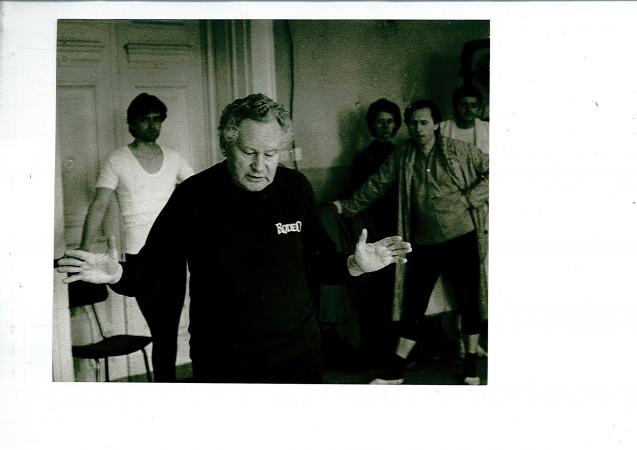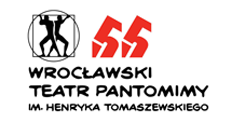Henryk Tomaszewski – dancer, mime, choreographer, director, teacher. The founder and director of the Wrocław Pantomime Theatre. Born on 20 November 1919 in Poznań. In 1945 he joined Iwo Gall’s Drama Studio in Cracow. He also took private lessons in dance. In 1946–1947 he collaborated with the Polish Academy Theatre, working on pantomime pieces and choreographies.
From 1946 till 1947 he studied and danced at the Feliks Parnell’s Polish Ballets. In 1949 he was engaged by the Wrocław Opera, where during a decade (till 1959) he played 11 roles. He was recognized for dramatized characters and innovative means of expression, in particular in the roles of Peacock (The Peacock and the Girl), Li Shan-fu (The Red Poppy), and Devil (Pan Twardowski) .
In May 1955 at the International Festival of Youth and Students in Warsaw he was awarded the silver medal for a short pantomime Wirtuoz which contributed to founding the Studio (1956) and later the Wrocław Pantomime Theatre (1959). Programme I was premiered on 4 November 1956. From the outset, Henryk Tomaszewski was consequently developing the style of group pantomime theatre – a unique phenomenon in world culture. He broke off with the French tradition of pure pantomime and ran his multidisciplinary formal experiments, exploring literature, myths and culture on which his performances were based. Visual and musical setting also played an important role in his performances. From the outset, he worked with the most outstanding Polish stage designers: Jadwiga Przeradzka, Zofia de Ines, Kazimierz Wiśniak, Franciszek Starowieyski, Andrzej Majewski, Władysław Wigura.He placed human and creative possibilities of movement at the centre of his artstic vision, called by him “spherical theatre”.
He acted on stage till 1962. His roles of Akakius in The Overcoat, title character in Wozeck or Death Figure in Strzelnica earned their place in the history books. Henryk Tomaszewski created in his theatre 24 Programmes; starting from Programme X Odejście Fausta, all of them were full-size performances. As the first person in Poland, he started to educate mimes, who after graduating from the Theatre’s Studio, were granted a status of professional mime-actor.
He created numerous choreographies for drama and opera performances. From 1967 he worked at drama theatres as a director; he made the performances original by seeking the roots of word in gesture and movement and by getting from actors some unexpected skills.
Reviews of his performances often included a word “masterpiece”. His production Jeux de massacre at Polski Theatre in Wrocław was recognized as equal to the Eugene Ionesco’s masterpiece. As a director, he also worked abroad, including Sweden, Norway and West Germany. He would also present his Wrocław performances in theatres in Amsterdam, Oslo and Copenhagen. As a choreographer and producer, he worked in Polish, Danish and German opera theatres.
He particularly valued two productions: Hans Werner Henze’s Menada created with Konrad Świniarski for La Scala (Milan) and Carlheinz Stockhausen’s Dienstag aus Licht for the Leipzig Opera.
Henryk Tomaszewski was also a famous collector. In November 1994, the Municipal Museum of Toys from Henryk Tomaszewski’s collection (since 1967), was opened in Karpacz. The collection includes toys from the 17th to the 20th century.
Henryk Tomaszewski died on 23 September 2001 in Kowary. He was buried in the old graveyard of the Wang temple in Karpacz.
QUOTES:
Movement is the affirmation of life. Movement means life to me, thus I think that movement mirrors my life. It broadens my own existence, generalises it, carries it around, but at the same time – sums it up. It all forces me to pay the most attention to movement – I build my theatre via movement.
*
Modern art is in fact the example of word devaluation. It becomes a slur, losing its main purpose as a means of communication. The artists become as if embarrassed or mortified when they need to act the real emotions using the word. Yet people have not stopped to feel. (…) Here appears the movement – a means of communication that does not fear what the words dread to show.
*
Movement is a conflict of a scenic persona with the surroundings, like in the everyday life we deal with the conflict of a person and the outer world, including time. (…) The movement transforms the world, subdues it – at least it attempts to do it. The least complicated moves can create the drama performed by a person: the ceaseless struggle, undying struggle for life that is motionless. Therefore, mime can end up either dead, or with a new opportunity for a move.
All quotes from: Henryk Tomaszewski, Discussion on drama. Tomaszewski’s movement theatre, interview by Andrzej Hausbrandt, Dialog XIV, No. 10 (162), pages 119–125.

